Milk bread is a favorite among bread lovers, but have you ever wondered about its nutritional value? Understanding the nutritional facts of milk bread is important for those seeking a health-conscious choice. In this article, we will uncover the calorie content, explore the overall nutritional profile, and highlight the potential health benefits of milk bread.
- Milk bread contains approximately 300 calories per serving of 100 grams.
- It is high in carbohydrates, with 60.7 grams per serving.
- Milk bread has a moderate amount of protein at 9.8 grams.
- The fat content in milk bread is low, with 1.5 grams per serving.
- Milk bread is low in sodium and cholesterol.
With its good source of calcium and iron, milk bread can be a part of a healthy diet, especially for those watching their calorie intake or aiming for heart-healthy options. So, let’s dive deeper into the nutritional facts of milk bread and discover why it’s a great choice for bread lovers looking for a balance between taste and nutrition.
Uncover the Calorie Content of Milk Bread
Let’s take a closer look at the calorie content of milk bread and find out how it compares to other types of bread. When it comes to tracking calorie intake, understanding the nutritional facts of milk bread is crucial. A serving of 100 grams of milk bread contains approximately 300 calories. This makes it a relatively moderate-calorie option for those looking to maintain a balanced diet.
In comparison to other bread varieties, milk bread falls within a similar calorie range. For instance, whole wheat bread typically contains around 270-290 calories per serving, while white bread can have 250-270 calories. These numbers indicate that milk bread is a viable option that can fit into different dietary preferences and calorie goals.
While calorie content is important, it’s also essential to consider the other nutritional aspects of milk bread. This type of bread is high in carbohydrates, with 60.7 grams per serving, providing a good source of energy for the body. It also contains a moderate amount of protein, at 9.8 grams per serving, which is essential for muscle repair and overall health. With a low fat content of just 1.5 grams per serving, milk bread offers a balanced composition that fits well into a variety of dietary plans.
Overall, the calorie content of milk bread is comparable to other bread types, making it a versatile choice for individuals seeking a health-conscious option. Whether you’re looking to manage your calorie intake or incorporate heart-healthy bread into your diet, milk bread can be a tasty and nutritious choice to consider.
| Bread Type | Calories per Serving (100g) |
|---|---|
| Milk Bread | 300 |
| Whole Wheat Bread | 270-290 |
| White Bread | 250-270 |
The Nutritional Profile of Milk Bread
Understanding the nutritional profile of milk bread is key to making informed decisions about your diet. Let’s take a closer look at the facts and figures that make up the nutritional content of this popular bread option.

According to the nutritional information, milk bread contains approximately 300 calories per serving of 100 grams. While this may seem high, it’s important to consider the overall composition of the bread.
One serving of milk bread provides 60.7 grams of carbohydrates, making it a significant source of energy. Carbohydrates are essential for fueling the body and supporting various bodily functions.
In terms of protein content, milk bread offers 9.8 grams per serving. Protein is crucial for building and repairing tissues, as well as supporting the growth and maintenance of muscles.
When it comes to fat, milk bread is relatively low with 1.5 grams per serving. This makes it a favorable choice for those watching their fat intake or following a heart-healthy diet.
Additionally, milk bread is low in sodium and cholesterol, making it a suitable option for individuals looking to reduce their intake of these substances. It contains significant amounts of calcium and iron, which are essential minerals for maintaining strong bones and supporting overall health.
In summary, milk bread offers a moderate calorie count, a significant source of carbohydrates, a moderate amount of protein, and low fat content. It is also low in sodium and cholesterol while providing beneficial amounts of calcium and iron. These nutritional facts make milk bread a nutritious choice, especially for those who want to incorporate it into a healthy and balanced diet.
Carbohydrate Content of Milk Bread
Carbohydrates are an essential macronutrient, and milk bread is known for its higher carbohydrate content. In a serving of 100 grams, milk bread contains approximately 60.7 grams of carbohydrates. These carbs provide the body with the energy it needs to function throughout the day. The higher carbohydrate content in milk bread makes it a filling and satisfying option, perfect for those who have active lifestyles or need a quick energy boost.
Not only does milk bread provide a good source of carbohydrates, but it also offers other important nutrients. It contains 9.8 grams of protein per serving, which is necessary for muscle building and repair. Additionally, milk bread is low in fat, with only 1.5 grams per serving. This makes it a healthier choice compared to other types of bread that may contain higher fat levels.
To better understand the nutritional value of milk bread, let’s take a closer look at the complete nutritional profile:
| Nutrient | Amount per serving (100g) |
|---|---|
| Calories | 300 |
| Carbohydrates | 60.7g |
| Protein | 9.8g |
| Fat | 1.5g |
| Sodium | Low |
| Cholesterol | Low |
| Calcium | Good source |
| Iron | Good source |
As seen in the table above, milk bread is not only rich in carbohydrates but also provides a moderate amount of protein and essential minerals such as calcium and iron. These nutritional facts indicate that milk bread can be a valuable addition to a healthy diet, especially for those watching their calorie intake or aiming for heart-healthy options. So the next time you’re looking for a delicious and nutritious bread option, consider choosing milk bread!
Protein Content of Milk Bread
While milk bread is not as high in protein as some other bread varieties, it still contributes to your daily protein needs. Each serving of milk bread, which is approximately 100 grams, contains around 9.8 grams of protein. Protein is an essential macronutrient that plays a crucial role in repairing and building tissues, including muscles, skin, and organs. It is also involved in various metabolic processes, such as enzyme production and hormone synthesis.
Including milk bread in your diet can be a way to incorporate a moderate amount of protein. If you’re looking to increase your overall protein intake, you can consider pairing milk bread with protein-rich toppings or fillings. For example, adding sliced turkey or chicken breast, lean ham, or hard-boiled eggs can enhance the protein content of your milk bread sandwich or toast.
By carefully selecting your milk bread toppings, you can create a balanced and wholesome meal that provides both carbohydrates and protein. This combination can help you feel satiated and energized throughout the day. Additionally, milk bread is a versatile choice that can be enjoyed in various forms, such as sandwiches, toast, or even as breadcrumbs for coating meat or vegetables.
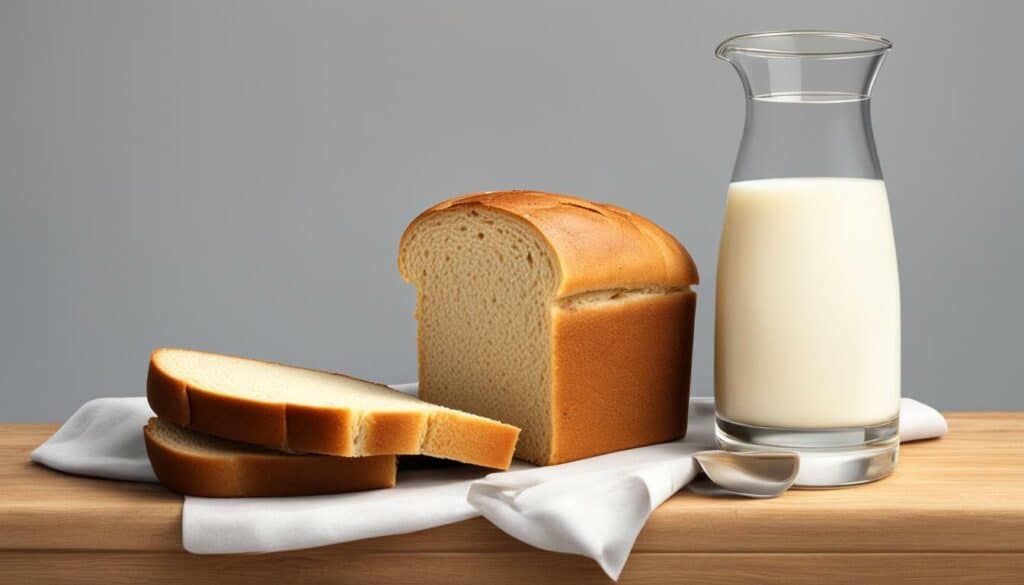
| Serving Size | Protein Content |
|---|---|
| 100 grams | 9.8 grams |
Remember that while milk bread provides a moderate amount of protein, it is important to have a varied diet that includes other protein sources, such as lean meats, fish, legumes, and dairy products. This ensures that you receive a wide range of essential amino acids and meet your body’s protein requirements.
Fat Content of Milk Bread
If you’re watching your fat intake, milk bread can be a great choice as it contains a low amount of fat. With only 1.5 grams of fat per serving of 100 grams, this bread is a healthier option compared to other types of bread. It provides a satisfying and flavorful experience without compromising on your dietary goals.
Beyond its low fat content, milk bread also offers a range of nutritional benefits. It is high in carbohydrates, with 60.7 grams per serving, making it an excellent source of energy. The moderate amount of protein, at 9.8 grams per serving, contributes to muscle building and overall health.
Furthermore, milk bread is low in sodium and cholesterol, making it a heart-healthy choice. This bread also boasts a good amount of calcium and iron, essential minerals for maintaining strong bones and overall well-being.
If you’re looking for a delicious and nutritious bread option, milk bread is a fantastic choice. Its low fat content, high carbohydrate and protein content, and beneficial mineral profile make it an excellent addition to a healthy diet. So go ahead, enjoy a slice of milk bread knowing that you’re making a smart choice for your well-being.
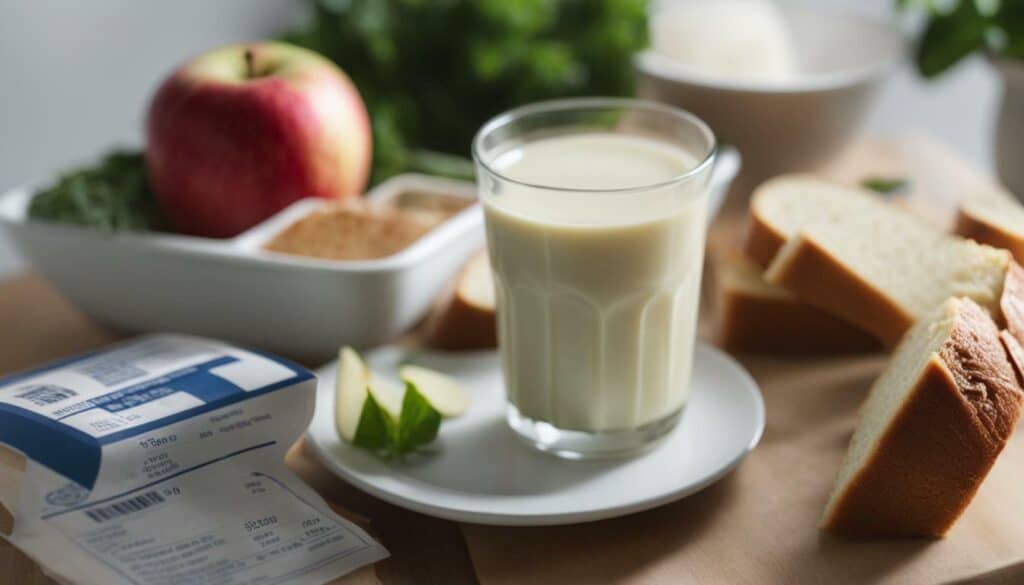
When it comes to sodium and cholesterol, milk bread is considered a heart-healthy option. It is low in both sodium and cholesterol, making it a favorable choice for those watching their cardiovascular health. With only 150 milligrams of sodium per serving, milk bread is a great alternative to other bread varieties that may contain excessive amounts of sodium.
Furthermore, milk bread contains zero cholesterol, which is important for maintaining healthy cholesterol levels and reducing the risk of heart disease. By choosing milk bread as your daily bread option, you can enjoy its delicious taste while also taking care of your cardiovascular well-being.
“Milk bread’s low sodium and cholesterol content make it an excellent choice for individuals looking to maintain a heart-healthy diet.”
In addition to being heart-friendly, milk bread is also rich in essential nutrients. It is a good source of calcium, providing about 10% of the recommended daily intake per serving. Calcium is crucial for maintaining strong bones and teeth, making milk bread an ideal choice for individuals of all ages.
Milk bread also contains iron, a mineral that supports the production of red blood cells and helps transport oxygen throughout the body. By incorporating milk bread into your diet, you can ensure that you are getting a good amount of iron to support your overall health and well-being.
| Nutrient | Amount per Serving (100g) |
|---|---|
| Calories | 300 |
| Carbohydrates | 60.7g |
| Protein | 9.8g |
| Fat | 1.5g |
| Sodium | 150mg |
| Cholesterol | 0mg |
| Calcium | 10% of the recommended daily intake |
| Iron | 4% of the recommended daily intake |
By choosing milk bread, you can enjoy a heart-healthy option that is low in sodium and cholesterol while providing essential nutrients like calcium and iron.
Calcium and Iron in Milk Bread
Milk bread is not only delicious but also packs a punch when it comes to providing essential minerals like calcium and iron. These two minerals play crucial roles in maintaining overall health and are especially important for strong bones and optimal bodily functions.
When it comes to calcium, milk bread is a valuable source, containing approximately 170 milligrams per serving of 100 grams. Calcium is essential for bone health and helps in the prevention of osteoporosis, a condition characterized by weakened bones. Incorporating milk bread into your diet can contribute to meeting your daily calcium needs and promoting bone strength.
Iron is another vital mineral found in milk bread, with approximately 3.6 milligrams per serving. Iron plays a key role in the production of red blood cells, which transport oxygen throughout the body. A sufficient intake of iron is necessary to prevent iron deficiency anemia, a condition that can lead to fatigue and weakness.
By enjoying milk bread, you not only savor its delectable taste but also benefit from the valuable minerals it provides. So, whether you’re enjoying a sandwich, toast, or simply a warm slice, indulge in the goodness of milk bread and give your body the nourishment it deserves.
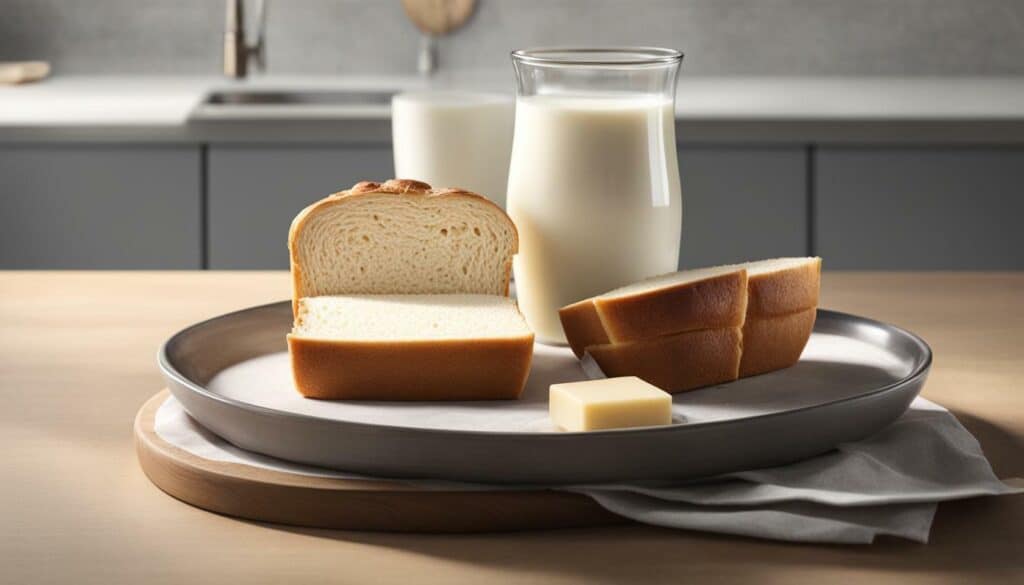
| Nutrient | Amount per Serving (100g) |
|---|---|
| Calories | 300 |
| Carbohydrates | 60.7g |
| Protein | 9.8g |
| Fat | 1.5g |
| Sodium | Low |
| Cholesterol | Low |
| Calcium | 170mg |
| Iron | 3.6mg |
Incorporating Milk Bread into a Healthy Diet
With its moderate calorie content and beneficial nutrients, milk bread can be a valuable addition to a balanced diet. This delicious bread option offers a range of health benefits while satisfying your cravings for a fluffy and wholesome treat.
When considering low-calorie options, milk bread stands out as a favorable choice. It contains approximately 300 calories per serving of 100 grams, making it a great option for individuals watching their calorie intake. Whether you’re aiming to maintain a healthy weight or looking for a guilt-free indulgence, incorporating milk bread into your daily meals can be a smart choice.
Not only is milk bread low in fat, with just 1.5 grams per serving, but it is also moderate in protein content, offering 9.8 grams per serving. This combination makes it a suitable option for those seeking a balanced diet that supports muscle maintenance and overall health. Additionally, milk bread is low in sodium and cholesterol, which can be beneficial for heart health.
Milk bread also provides a good source of two essential minerals: calcium and iron. Calcium plays a vital role in maintaining strong bones and teeth, while iron is important for carrying oxygen throughout the body. By incorporating milk bread into your meals, you can enhance your nutrient intake and support your overall well-being.

“Incorporating milk bread into my diet has been a game-changer. It’s my go-to choice when I want to enjoy a delicious snack without compromising my health goals. Plus, it’s so versatile – perfect for toasting, making sandwiches, or pairing with soups and salads. Highly recommended!” – Jane, milk bread enthusiast
Making Informed Choices: Milk Bread Calorie Calculator
If you’re conscious about your calorie intake, a milk bread calorie calculator can help you stay on track. It’s a handy tool that allows you to calculate the number of calories in your milk bread servings, giving you a better understanding of your overall dietary intake. By inputting the serving size and the nutritional information from the packaging, the calculator provides you with an accurate estimate of the calories you’re consuming.
Using a milk bread calorie calculator is simple and convenient. Just enter the serving size in grams and the nutritional facts, such as the calorie count per 100 grams, into the calculator. Once you click calculate, it will generate the number of calories in your specified serving size. This helps you make informed decisions about portion control and meal planning, ensuring you can enjoy milk bread without exceeding your desired calorie limits.
It’s important to note that milk bread calorie calculators are not limited to just calories. Some calculators may also provide additional nutritional information, such as carbohydrate, protein, fat, and mineral content. This comprehensive data allows you to have a more thorough understanding of the nutritional value of milk bread and make choices that align with your dietary goals.
With the help of a milk bread calorie calculator, you can make smarter choices that align with your health goals. Whether you’re following a specific diet plan or simply trying to maintain a balanced lifestyle, this tool empowers you to take control of your calorie intake and make informed decisions about your diet. So the next time you indulge in a delicious slice of milk bread, you can do so with confidence, knowing exactly what you’re consuming.
Sample Milk Bread Calorie Calculator:

| Serving Size (g) | Calories (per 100g) | Total Calories |
|---|---|---|
| 50 | 150 | 75 |
| 100 | 300 | 300 |
| 150 | 450 | 675 |
Exploring Other Varieties of Bread
While milk bread is popular, it’s always good to explore other bread varieties to diversify your diet. There are several options available, each with its own unique nutritional profile and taste. Let’s take a look at some alternatives to milk bread:
- Whole Wheat Bread: Made from whole wheat grains, this bread is rich in fiber and nutrients. It provides a hearty and slightly nutty flavor, making it a nutritious choice for those looking to incorporate more whole grains into their diet.
- Multigrain Bread: As the name suggests, multigrain bread is made from a mixture of different grains such as wheat, barley, oats, and flaxseeds. It offers a good amount of fiber, vitamins, and minerals, making it a wholesome option.
- Sourdough Bread: Known for its distinct tangy flavor, sourdough bread is made using a natural fermentation process. This bread is lower in phytic acid, making it easier to digest and potentially more beneficial for gut health.
- Rye Bread: Rye bread is made from rye grains and has a dense texture and robust flavor. It is a good source of fiber and provides essential nutrients like magnesium and selenium.
By incorporating these bread varieties into your diet, you can experience a range of flavors while also reaping the nutritional benefits they offer. Remember to choose whole grain options whenever possible, as they are typically higher in fiber and contain more vitamins and minerals compared to refined white bread.
Table: A Comparison of Bread Varieties
Below is a table comparing the nutritional highlights of milk bread, whole wheat bread, multigrain bread, sourdough bread, and rye bread:
| Bread Variety | Calories (per serving) | Carbohydrates (g) | Protein (g) | Fat (g) | Sodium (mg) | Cholesterol (mg) | Calcium (mg) | Iron (mg) |
|---|---|---|---|---|---|---|---|---|
| Milk Bread | 300 | 60.7 | 9.8 | 1.5 | 50 | 0 | 75 | 2.1 |
| Whole Wheat Bread | 82 | 15.6 | 3.6 | 0.9 | 165 | 0 | 29 | 1.0 |
| Multigrain Bread | 100 | 16.7 | 3.5 | 1.4 | 168 | 0 | 36 | 1.2 |
| Sourdough Bread | 93 | 18.9 | 3.8 | 0.9 | 101 | 0 | 34 | 1.1 |
| Rye Bread | 83 | 16.2 | 3.1 | 0.6 | 301 | 0 | 17 | 0.6 |
As you can see from the table, each bread variety has its own nutritional composition. By considering these options, you can choose a bread that aligns with your dietary needs and preferences. Remember to enjoy bread as part of a balanced diet and incorporate a variety of other nutritious foods for overall health and well-being.
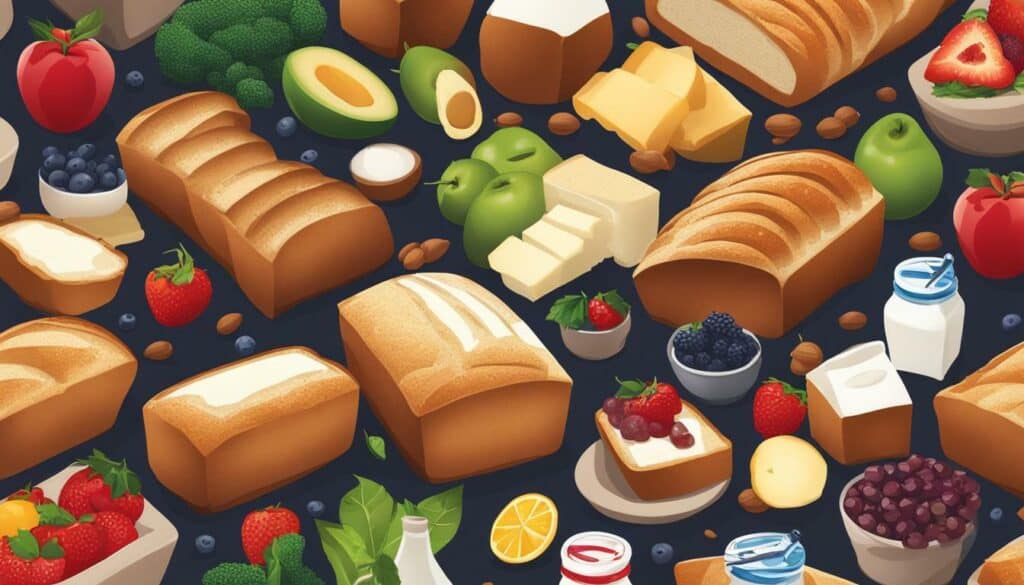
In conclusion, milk bread can be a delicious and health-conscious choice, with its moderate calorie content, low fat, and beneficial nutrients. According to the nutritional facts, a serving of 100 grams of milk bread contains approximately 300 calories. While this may seem higher compared to some other bread varieties, it is important to consider the overall nutritional profile and the potential health benefits it offers.
One key aspect of milk bread is its high carbohydrate content, with 60.7 grams per serving. Carbohydrates are essential for providing energy, and choosing a bread option that is rich in carbohydrates can be a great way to fuel your body throughout the day.
Additionally, milk bread provides a moderate amount of protein, with 9.8 grams per serving. Protein is crucial for building and repairing tissues, and including a decent protein source like milk bread in your diet can support muscle growth and overall health.
Furthermore, milk bread is relatively low in fat, with only 1.5 grams per serving. This makes it a favorable choice for those who are watching their fat intake or aiming for a heart-healthy lifestyle. The bread is also low in sodium and cholesterol, which can be beneficial for maintaining cardiovascular health.
Lastly, milk bread is a good source of calcium and iron. Calcium is essential for strong bones and teeth, while iron plays a vital role in carrying oxygen throughout the body. By choosing milk bread, you can incorporate these important minerals into your diet.
Overall, milk bread can be a nutritious and delicious addition to a health-conscious diet. Whether you are looking for a lower calorie option, a bread with low fat content, or a source of important nutrients, milk bread offers a variety of benefits. So next time you’re at the bakery, consider giving milk bread a try!
FAQ
Q: What is the calorie content of milk bread?
A: Milk bread contains approximately 300 calories per serving of 100 grams.
Q: How many carbohydrates are in milk bread?
A: Milk bread is high in carbohydrates, with 60.7 grams per serving.
Q: What is the protein content of milk bread?
A: Milk bread has a moderate amount of protein at 9.8 grams per serving.
Q: How much fat does milk bread contain?
A: Milk bread has a low fat content, with 1.5 grams per serving.
Q: Is milk bread high in sodium and cholesterol?
A: No, milk bread is low in sodium and cholesterol.
Q: What are the nutritional benefits of milk bread?
A: Milk bread is a good source of calcium and iron, which are important for maintaining strong bones and overall health.
Q: Can milk bread be part of a healthy diet?
A: Yes, milk bread can be a part of a healthy diet, especially for those watching their calorie intake or aiming for heart-healthy options.
How Many Carbs are in Milk Bread?
Milk bread is a popular choice for breakfast or sandwiches, but have you ever wondered about the carbs in milk bread? Well, the exact carb content may vary depending on the brand or recipe, but on average, a single slice of milk bread contains around 15-20 grams of carbs. So, if you’re watching your carb intake, it’s always good to keep an eye on the carbs in milk bread to make informed dietary choices.

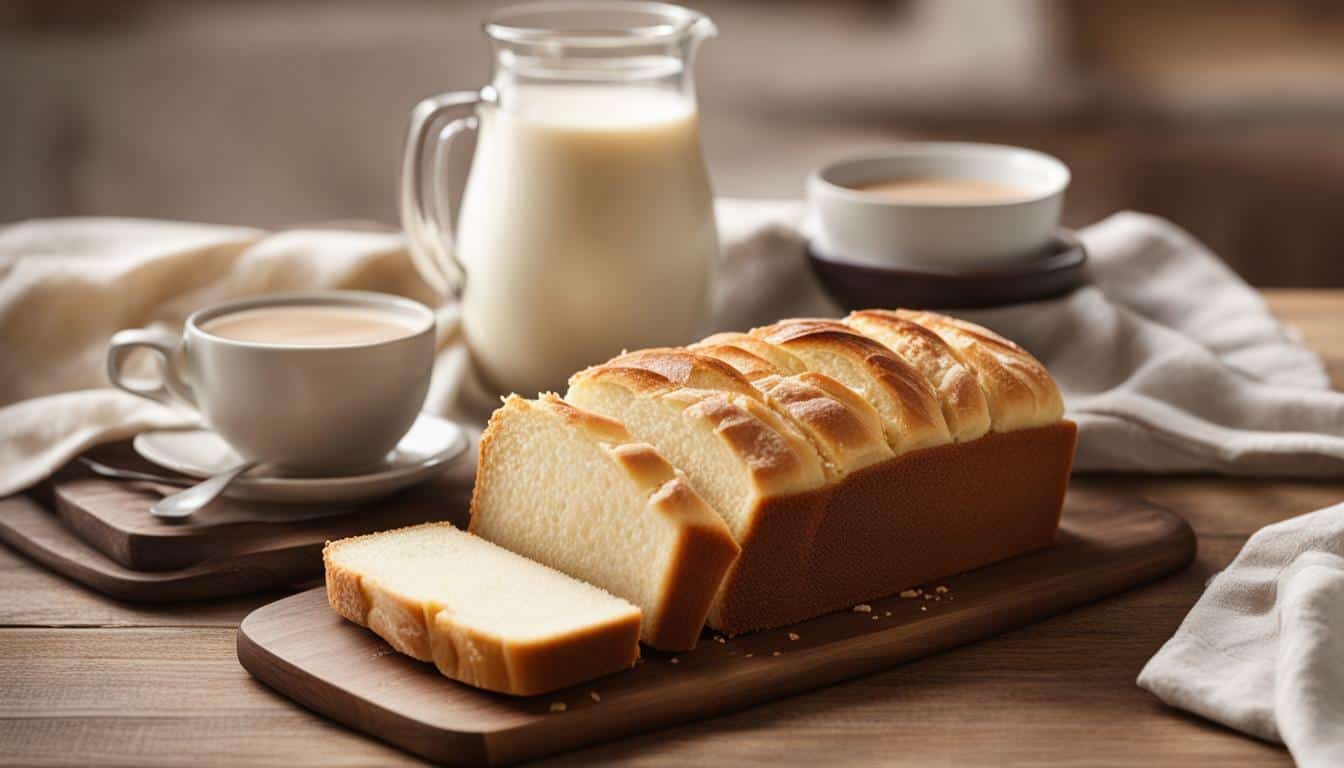



Leave a Reply